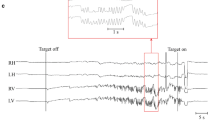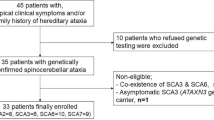Abstract
Down syndrome (DS), the most common genetically defined cause of intellectual disability, is the phenotypic consequence of a supernumerary chromosome 21. Persons with DS commonly display deficits in visuomotor integration, motor coordination, and balance. Despite the key roles of the optokinetic and vestibular systems in these submodalities of motor function, a systematic investigation into the optokinetic nystagmus (OKN) and vestibulo-ocular reflex (VOR) in persons with DS was lacking in the literature. Accordingly, this study generated quantitative data on oculomotor function in persons with DS under vestibular stimulation (an accompanying work describes results on the analysis of optokinetic function in the same cohort of participants). Experiments involved 32 participants with DS (14–36 years old, equally divided by gender) and 32 chronological age- and gender-matched typically developing controls. Eye movements were recorded by binocular video-oculography, and a servo-controlled rotary chair produced vestibular stimulation. Participants were assessed for VOR during step, ramp, and sinusoidal stimulations; inhibition of the VOR by visual target fixation; and VOR adaptation to conflicting visual input. Individuals with DS displayed small alterations in the VOR gain and dynamics compared to controls. In contrast, the number of VOR nystagmus beats and the ability to inhibit the VOR by visual target fixation were markedly and robustly smaller in persons with DS. Significantly increased VOR adaptation was observed in men with DS. These findings may have implications to the understanding of the neurological basis of the motor dysfunction that affects performance in many practical tasks persons with DS encounter in their everyday lives.








Similar content being viewed by others
References
Agiovlasitis S, McCubbin JA, Yun J, Mpitsos G, Pavol MJ (2009) Effects of Down syndrome on three-dimensional motion during walking at different speeds. Gait Posture 30:345–350
Aruin AS, Almeida GL, Latash ML (1996) Organization of a simple two-joint synergy in individuals with Down syndrome. Am J Ment Retard 101:256–268
Averbuch-Heller L, Dell’Osso LF, Jacobs JB, Remler BF (1999) Latent and congenital nystagmus in Down syndrome. J Neuroophthalmol 19:166–172
Baarsma E, Collewijn H (1974) Vestibulo-ocular and optokinetic reactions to rotation and their interaction in the rabbit. J Physiol 238:603–625
Baxter LL, Moran TH, Richtsmeier JT, Troncoso J, Reeves RH (2000) Discovery and genetic localization of Down syndrome cerebellar phenotypes using the Ts65Dn mouse. Hum Mol Genet 9:195–202
Blair S, Gavin M (1979) Modification of the macaque’s vestibulo-ocular reflex after ablation of the cerebellar vermis. Acta Otolaryngol 88:235–243
Blaser S, Propst EJ, Martin D, Feigenbaum A, James AL, Shannon P, Papsin BC (2006) Inner ear dysplasia is common in children with Down syndrome (trisomy 21). Laryngoscope 116:2113–2119
Bodensteiner JB, Smith SD, Schaefer GB (2003) Hypotonia, congenital hearing loss, and hypoactive labyrinths. J Child Neurol 18:171–173
Capone GT, Grados MA, Kaufmann WE, Bernad-Ripoll S, Jewell A (2005) Down syndrome and comorbid autism-spectrum disorder: characterization using the aberrant behavior checklist. Am J Med Genet A 134:373–380
Carvalho RL, Almeida GL (2009) Assessment of postural adjustments in persons with intellectual disability during balance on the seesaw. J Intellect Disabil Res 53:389–395
Cohen H (1989) Testing vestibular function: problems with the Southern California Postrotary Nystagmus Test. Am J Occup Ther 43:475–477
Cohen B, Helwig D, Raphan T (1987) Baclofen and velocity storage: a model of the effects of the drug on the vestibulo-ocular reflex in the rhesus monkey. J Physiol 393:703–725
Collewijn H, Martins AJ, Steinman RM (1981) Natural retinal image motion: origin and change. Ann NY Acad Sci 374:312–329
Costa AC, Walsh K, Davisson MT (1999) Motor dysfunction in a mouse model for Down syndrome. Physiol Behav 68:211–220
Costa AC, Stasko MR, Schmidt C, Davisson MT (2010) Behavioral validation of the Ts65Dn mouse model for Down syndrome of a genetic background free of the retinal degeneration mutation Pde6b(rd1). Behav Brain Res 206:52–62
Cramer NP, Best TK, Stoffel M, Siarey RJ, Galdzicki Z (2010) GABAB-GIRK2-mediated signaling in Down syndrome. Adv Pharmacol 58:397–426
Cullen KE, Chen-Huang C, McCrea RA (1993) Firing behavior of brain stem neurons during voluntary cancellation of the horizontal vestibuloocular reflex. II. Eye movement related neurons. J Neurophysiol 70:844–856
Cullen KE, Minor LB, Beraneck M, Sadeghi SG (2009) Neural substrates underlying vestibular compensation: contribution of peripheral versus central processing. J Vestib Res 19:171–182
Davisson MT, Schmidt C, Akeson EC (1990) Segmental trisomy of murine chromosome 16: a new model system for studying Down syndrome. Prog Clin Biol Res 360:263–280
Demer JL, Porter FI, Goldberg J, Jenkins HA, Schmidt K (1989) Adaptation to telescopic spectacles: vestibulo-ocular reflex plasticity. Invest Ophthalmol Vis Sci 30:159–170
du Lac S, Lisberger SG (1995) Cellular processing of temporal information in medial vestibular nucleus neurons. J Neurosci 15:8000–8010
Grusser-Cornehls U, Bohm P (1988) Horizontal optokinetic ocular nystagmus in wildtype (B6CBA+/+) and weaver mutant mice. Exp Brain Res 72:29–36
Hampton TG, Stasko MR, Kale A, Amende I, Costa AC (2004) Gait dynamics in trisomic mice: quantitative neurological traits of Down syndrome. Physiol Behav 82:381–389
Illing S, Choy NL, Nitz J, Nolan M (2010) Sensory system function and postural stability in men aged 30–80 years. Aging Male 13:202–210
Koo BK, Blaser S, Harwood-Nash D, Becker LE, Murphy EG (1992) Magnetic resonance imaging evaluation of delayed myelination in Down syndrome: a case report and review of the literature. J Child Neurol 7:417–421
Lam MY, Hodges NJ, Virji-Babul N, Latash ML (2009) Evidence for slowing as a function of index of difficulty in young adults with Down syndrome. Am J Intellect Dev Disabil 114:411–426
Latash ML, Anson JG (2006) Synergies in health and disease: relations to adaptive changes in motor coordination. Phys Ther 86:1151–1160
Leigh J, Zee D (2006) The neurology of eye movements. Oxford University Press, New York
Li Z, Yu T, Morishima M, Pao A, LaDuca J, Conroy J, Nowak N, Matsui S, Shiraishi I, Yu YE (2007) Duplication of the entire 22.9 Mb human chromosome 21 syntenic region on mouse chromosome 16 causes cardiovascular and gastrointestinal abnormalities. Hum Mol Genet 16:1359–1366
Lisberger SG, Pavelko TA, Bronte-Stewart HM, Stone LS (1994) Neural basis for motor learning in the vestibuloocular reflex of primates. II. Changes in the responses of horizontal gaze velocity Purkinje cells in the cerebellar flocculus and ventral paraflocculus. J Neurophysiol 72:954–973
Lott IT, Dierssen M (2010) Cognitive deficits and associated neurological complications in individuals with Down’s syndrome. Lancet Neurol 9:623–633
Lund J (1988) Psychiatric aspects of Down’s syndrome. Acta Psychiatr Scand 78:369–374
MacDougall HG, Weber KP, McGarvie LA, Halmagyi GM, Curthoys IS (2009) The video head impulse test: diagnostic accuracy in peripheral vestibulopathy. Neurology 73:1134–1141
Molnar GE (1978) Analysis of motor disorder in retarded infants and young children. Am J Ment Defic 83:213–222
Nakada T, Kwee IL (1982) Floccular inhibition of the vestibulo-ocular reflex in man. J Clin Neuroophthalmol 2:201–207
Niklasson M, Tham R, Larsby B, Eriksson B (1994) Effects of GABAB activation and inhibition on vestibulo-ocular and optokinetic responses in the pigmented rat. Brain Res 649:151–158
O’Doherty A, Ruf S, Mulligan C, Hildreth V, Errington ML, Cooke S, Sesay A, Modino S, Vanes L, Hernandez D, Linehan JM, Sharpe PT, Brandner S, Bliss TV, Henderson DJ, Nizetic D, Tybulewicz VL, Fisher EM (2005) An aneuploid mouse strain carrying human chromosome 21 with Down syndrome phenotypes. Science 309:2033–2037
Olson LE, Roper RJ, Baxter LL, Carlson EJ, Epstein CJ, Reeves RH (2004) Down syndrome mouse models Ts65Dn, Ts1Cje, and Ms1Cje/Ts65Dn exhibit variable severity of cerebellar phenotypes. Dev Dyn 230:581–589
Raphan T, Matsuo V, Cohen B (1979) Velocity storage in the vestibulo-ocular reflex arc (VOR). Exp Brain Res 35:229–248
Raz N, Torres IJ, Briggs SD, Spencer WD, Thornton AE, Loken WJ, Gunning FM, McQuain JD, Driesen NR, Acker JD (1995) Selective neuroanatomic abnormalities in Down’s syndrome and their cognitive correlates: evidence from MRI morphometry. Neurology 45:356–366
Roy JE, Cullen KE (2002) Vestibuloocular reflex signal modulation during voluntary and passive head movements. J Neurophysiol 87:2337–2357
Sago H, Carlson EJ, Smith DJ, Kilbridge J, Rubin EM, Mobley WC, Epstein CJ, Huang TT (1998) Ts1Cje, a partial trisomy 16 mouse model for Down syndrome, exhibits learning and behavioral abnormalities. Proc Natl Acad Sci USA 95:6256–6261
Schonewille M, Belmeguenai A, Koekkoek SK, Houtman SH, Boele HJ, van Beugen BJ, Gao Z, Badura A, Ohtsuki G, Amerika WE, Hosy E, Hoebeek FE, Elgersma Y, Hansel C, De Zeeuw CI (2010) Purkinje cell-specific knockout of the protein phosphatase PP2B impairs potentiation and cerebellar motor learning. Neuron 67:618–628
Scott-McKean JJ, Chang B, Hurd RE, Nusinowitz S, Schmidt C, Davisson MT, Costa AC (2010) The mouse model of Down syndrome Ts65Dn presents visual deficits as assessed by pattern visual evoked potentials. Invest Ophthalmol Vis Sci 51:3300–3308
Scudder CA, Fuchs AF (1992) Physiological and behavioral identification of vestibular nucleus neurons mediating the horizontal vestibuloocular reflex in trained rhesus monkeys. J Neurophysiol 68:244–264
Shumway-Cook A, Woollacott MH (1985) Dynamics of postural control in the child with Down syndrome. Phys Ther 65:1315–1322
Simons B, Buttner U (1985) The influence of age on optokinetic nystagmus. Eur Arch Psychiatry Neurol Sci 234:369–373
Van Neerven J, Pompeiano O, Collewijn H (1991) Effects of GABAergic and noradrenergic injections into the cerebellar flocculus on vestibulo-ocular reflexes in the rabbit. Prog Brain Res 88:485–497
Welsh TN, Hoang S, Chandrasekharan S, Paulson S, Lynnes A, Ayres F (2009) Goal-directed saccades of young adults with and without Down syndrome. Down Syndr Quart 11:10–15
Wilson V, Melvill Jones G (1979) Mammalian vestibular physiology. Plenum Press, New York
Yamada M, Inanobe A, Kurachi Y (1998) G protein regulation of potassium ion channels. Pharmacol Rev 50:723–757
Yu T, Li Z, Jia Z, Clapcote SJ, Liu C, Li S, Asrar S, Pao A, Chen R, Fan N, Carattini-Rivera S, Bechard AR, Spring S, Henkelman RM, Stoica G, Matsui S, Nowak NJ, Roder JC, Chen C, Bradley A, Yu YE (2010) A mouse model of Down syndrome trisomic for all human chromosome 21 syntenic regions. Hum Mol Genet 19:2780–2791
Zee-Chen EL, Hardman ML (1983) Postrotary nystagmus response in children with Down’s syndrome. Am J Occup Ther 37:260–265
Acknowledgments
This study was supported by the Coleman Institute for Cognitive Disabilities, Boulder, Colorado. The author also received salary support from the National Institute of Child Health and Human Development (NICHD) Grants HD37424 and HD056235 and from the Linda Crnic Institute during the data analysis phase of this project. This study could not have been carried out without the enthusiastic support of the participants in the study and the Mile High Down Syndrome Association. The author is indebted to the anonymous expert reviewers of this manuscript for their constructive and insightful comments.
Author information
Authors and Affiliations
Corresponding author
Rights and permissions
About this article
Cite this article
Costa, A.C.S. An assessment of the vestibulo-ocular reflex (VOR) in persons with Down syndrome. Exp Brain Res 214, 199–213 (2011). https://doi.org/10.1007/s00221-011-2820-y
Received:
Accepted:
Published:
Issue Date:
DOI: https://doi.org/10.1007/s00221-011-2820-y




